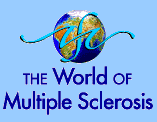 |
 |
. |
Human Stem Cells Replace Damaged
Brain Cells Human neural stem cells can replace and take over the functions of damaged nervous system cells in a mouse model of multiple sclerosis (MS) and related diseases, according to a study presented at the American Neurological Association's 125th annual meeting, October 15 through 18 in Boston. "Our results indicate that cell replacement therapy using human neural stems cells could be an effective therapy for MS patients," said lead author Seung U. Kim, MD, a neurologist at the University of British Columbia in Vancouver. The results are also significant for other neurological disorders such as Parkinson's disease or stroke, in which researchers hope neural stem cells will be able to replace damaged cells. Multiple sclerosis is a disorder of the nerve fibers of the brain and spinal cord. In MS patients, scarring (sclerosis) replaces myelin, a substance that normally insulates the nerves and speeds electrical conduction through the fibers. Depending on which nerve fibers are hindered, patients can experience problems ranging from weakness and clumsiness to numbness, visual disturbances, and even emotional and intellectual changes. Some patients experience MS as cycles of relapse and remission; others progress to severe debilitation and may die from the disease . The myelin is itself part of neural cells called oligodendrocytes, and one goal of Kim's research is to replace the lost oligodendrocytes with new ones derived from neural stem cells. Neural stem cells are immature cells that have the potential to develop into various types of neurons (the information-conveying cells of the nervous system) or different varieties of glial cells (which support and nourish the neurons), such as oligodendrocytes. A first step in that direction was achieved recently when Kim and his colleagues managed to induce stem cells from the brains of human fetuses to continue to grow and produce new cells in laboratory dishes, a process referred to as "immortalization." "In the present study, we transplanted these human neural stem cells into the brains of mutant "shiverer" mice, which have myelin disease throughout the brain and spinal cord, and demonstrated remyelination of previously unmyelinated fibers by the implanted cells," said Kim. Since shiverer mice show functional deficits such as tremor and a "shivering" gait, the researchers intend to determine whether neural cell transplantation reverses this motor dysfunction. Their preliminary observations of the animals in this study indicated that there was considerable reduction in tremor in many of the mice. The implications of this line of research go well beyond MS and other demyelinating diseases. "Since the neural stem cells exhibit self-renewal and possess multilineage potential, they could be utilized for cell replacement therapy for other neurological diseases such as Parkinson's disease, Huntington's disease, motor neuron diseases, Alzheimer's disease and stroke. Previous transplantation studies in animal models of these diseases indicate that cell replacement therapy is feasible," said Kim. Indeed, Kim and his group presented a separate study at the ANA meeting showing that the same human neural stem cells genetically modified to produce the neurotransmitter dopamine and then implanted in the brain of a rat model of Parkinson's disease were able to ameliorate the movement problems of that disorder. Р’В©American Neurological Association
(ANA) |
 | ||